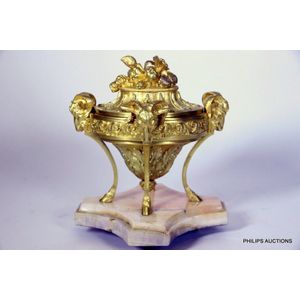Antique Louis XVI Style Ormolu Trinket Casket
You must be a subscriber, and be logged in to view price and dealer details.
Subscribe Now to view actual auction price for this item
When you subscribe, you have the option of setting the currency in which to display prices to $Au, $US, $NZ or Stg.
- Ormolu - Ormolu was popular with French craftsmen in the 18th and 19th century for ornamental fittings for furniture, clocks and other decorative items. True ormolu is gilt bronze, that is bronze that has been coated with gold using a mercury amalgam. Due to the health risks associated with using mercury, this method of creating ormolu was discontinued in France in the 1830s. A substitute was developed consisting of about 75% copper and 25% zinc, however it was inferior to the bronze version. It was often lacquered to prevent it tarnishing.
- Circa - A Latin term meaning 'about', often used in the antique trade to give an approximate date for the piece, usually considered to be five years on either side of the circa year. Thus, circa 1900 means the piece was made about 1900, probably between 1895 and 1905. The expression is sometimes abbreviated to c.1900.
- Acanthus - A stylized leaf motif, one of the primary decorative elements of classical Greek and Roman architecture, derived from the genus of flowering plants in the family Acanthaceae, native to tropical and subtropical regions of the Mediterranean area. It is a common element in classical Greek and Roman design, and is often seen in Corinthian and Composite order columns and used as a decorative element in English, European and Australian furniture, particularly on the curve of a leg, and as decoration for a corbel.
- Finial - An architectural decoration, found on the upper parts of of an object. On furniture they are usually found on pediments, canopies and shelf supports. On smaller ceramic or silver items, such as spoons, they may decorate the top of the item itself, or the lid or cover where they provide a useful handle for removal.
Finials have a variety of shapes and forms. They may be urn-shaped, baluster shaped round or spiral, but usually taper into an upper point. Many real life shapes may also be used as finials, such as pineapples, berries, pinecones, buds, lotus and acorns. Sometimes animals such as a lion are depicted, or fish and dolphins.
This item has been included into following indexes:
- boxes, material or decoration
Visually similar items

A Louis XV style giltwood hall mirror, 20th century, 110 cm high, 80 cm wide

A rare pair of Mintons tete d'elephant gilt metal mounted porcelain vases, circa 1878 each with twin rose shaped candle branches, figurative and floral cartouches to cobalt blue and gilt vermicule reserves. Impressed Mintons, year cypher and further potter

A Continental porcelain urn vase, in rococo style, with painted classical scenes depicting a nude lady on one side and the other three nobles by a lake having tea. Double handles with applied blooming roses and scrolled feet, heightened in gilt. Meissen bl

A Belle Epoque diamond pendant, centered with a cushion cut diamond of 2.30cts, suspended within a pierced bow, floral and foliate fitting set with single and rose cut diamonds, mounted in platinum, to a conforming fine trace chain, total length 395 mm.
